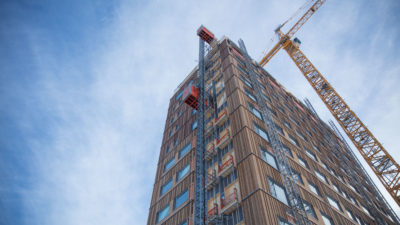Mass timber construction is on the rise, with advocates saying it could revolutionize the building industry and be part of a climate change solution. But some are questioning whether the logging and manufacturing required to produce the new material outweigh any benefits.
 Mjösa Tower, the world’s tallest wooden building, under construction in Brumunddal, Norway. ANTI HAMAR
Mjösa Tower, the world’s tallest wooden building, under construction in Brumunddal, Norway. ANTI HAMAR
The eight-story Carbon 12 building in Portland, Oregon is the tallest commercial structure in the United States to be built from something called mass timber.
If the many fervent boosters of this new construction material are right, however, it is only one of the first mass timber buildings among many, the beginning of a construction revolution. “The design community in Portland is enthralled with the material,” said Emily Dawson, an architect at Kaiser + Path, the locally-based firm that designed Carbon 12.
The move to mass timber is even farther along in Europe. That’s because mass timber – large structural panels, posts, and beams glued under pressure or nailed together in layers, with the wood’s grain stacked perpendicular for extra strength – is not only prized as an innovative building material, superior to concrete and steel in many ways, it is also hoped it will come into its own as a significant part of a climate change solution.
The possible prodigious climate benefits are what has many people taking mass timber seriously.
“We want to debunk the myth that mass timber is in any way, shape, or form related to some kind of environmental benefit,” said John Talberth, president of the Center for Sustainable Economy, which is based near Portland. “That’s simply not true.”
Yet proponents say mass timber does have real promise as a way to sequester massive amounts of CO2, if a fully sustainable life cycle comes together. “We are working with a large interdisciplinary team of climate scientists, carbon cycle researchers, metallurgists, and foresters to really understand the potential climate impacts of mass timber at scale,” said Ruff. MORE
